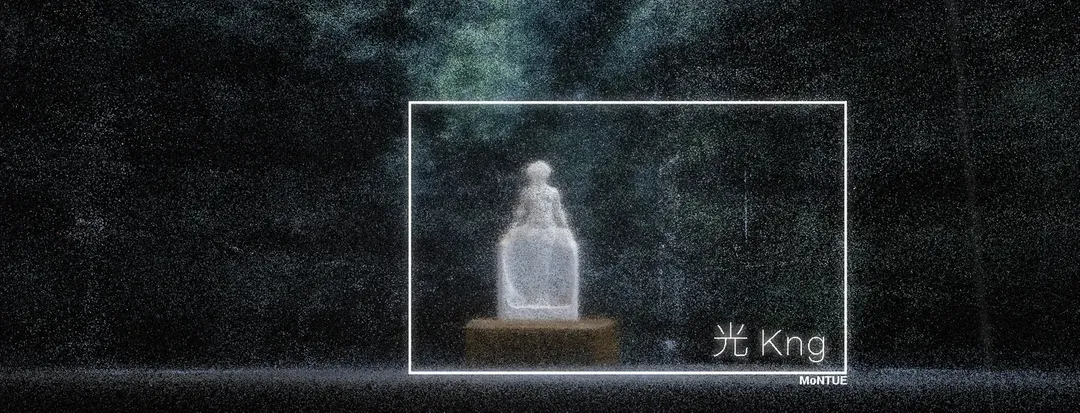How NFT has become a new medium for the participation of the art museum community. Take Kng NFT and “Lumiere - The Enlightenment and Self-awareness of Taiwanese Culture" as an example.
Written by mashbean (FAB DAO)
“Kng” is an NFT project derived from the exhibition “Lumiere - The Enlightenment and Self-awareness of Taiwanese Culture” at the Museum of National Taipei University of Education (hereinafter referred to as MoNTUE), and is the first museum NFT project in Taiwan to integrate the concept of mass participation. In addition to Kng NFT, Kng DAO is a digital community of art run by MoNTUE with the goal of becoming a DAO (decentralized governance organization).

The main goal of this article is to discuss how cultural institutions such as art museums can use NFT (non-funglible tokens) as an extensional tempt of galleries, exhibitions, and artworks to become a new type of cultural activity. This article is a single narrative and a case study of the process from March to June 2022, starting with the conception of the project and ending with the action, including the objectives, methods and results.
NFT is a digital asset that is recognized by a relatively large number of people. It is similar to the concept of digital property that has not been widely recognized and distributed in the past, such as the issuance of virtual tokens by private companies and virtual treasures by the online game. FAB DAO (Formosa Art bank DAO) focuses on the research and practice of Non-Profit NFT, which is a "spiritual value" of culture. We use NFT as strengthening the function of cultural property transaction. This article is a case study of Kng NFT, a collaboration between MoNTUE, the curating team, and FAB DAO.
In fact, it is not a new idea for museums and galleries to exploring the feasibility of NFT, as WAC Lab (Unlocking Web3 for the Arts and Culture, a initiative for cultural and exhibition discussions on the Tezos blockchain, run by We Are Museum, eight European museums and the Tezos Foundation) published a conversation in April in 2022. In April, We Are Museum published a conversation summary entitled NFTs Aren't A Get-Rich-Quick Scheme, Here's How Museums Can Use Them In Fundraising. Here's How Museums Can Use Them In Fundraising," an article that analyzes a number of museums' "failed" distribution cases in an attempt to sanitize and demystify the cultural workforce who is in the entrance level of NFT. The article concludes that “mass participation" will be the key to the success of museums' NFT launches. I think Kng NFT is a successful and early attempt.
Perhaps it was a coincidence, or perhaps we were deeply nurtured by Taiwanese culture and justified naming our organization Formosa Art Bank. This exhibition, Lumiere, is an exploration of the dawn of the Formosan Art Era (quoted from the first chapter of the catalogue of the same name as Lumiere, entitled "The Prayer of /Water of immortalilty/ - The Dawn of thege of Formosan Art" by Ms. Yen Chuan-Ying). I am very fortunate and humbled to thank MoNTUE and the curating team of “Lumiere” for allowing us to participate in this exhibition.

Before we get into the story, let me introduce Taiwan, the museum, and the significance of this exhibition for international readers. (If you are a Taiwanese, you can skip this paragraph)
What is Taiwan?
Taiwan is an island located on the eastern coast of the Asian continent, known by the name Formosa (Portuguese for beautiful island, a name associated with Age of Discovery). There are currently 23 million people living on the island, with Chinese as the main language and a majority of Taiwanese self-identifying (94%, according to the National Chengchi University Election Research Center 2021). After being ruled by the Chinese dynasty for hundreds of years, it was ruled by Japan for fifty years from 1895-1945 A.D. and then by the government of the Republic of China (R.O.C.) after 1945 A.D. Despite being the 18th Economic Sovereign Entities in the world, it is still not recognized by most of the countries in the world. The reason for this is that the People's Republic of China (P.R.C) does not recognize two Chinas and unilaterally does not allow Taiwan to become independent. In the past few decades, Taiwan has moved from an authoritarian regime to an era of democratization, and all sectors (such as sports, politics, arts and culture) are often confronted with issues of self-identification and unification. In a nutshell, Taiwan is located on the border of power (The U.S vs. China), and even though the economy is booming, it is still an orphan in Asia. (アジアの孤児, published in 1946, is a Japanese novel by author Wu Cho-liu, describing the dilemma of Taiwanese identity at that time)

What is "Lumiere - The Enlightenment and Self-awareness of Taiwanese Culture"?
This is an exhibition from late 2021 to mid-April 2022 showcasing archival research on modern art and the Taiwan Cultural Association movement.

The year 2021 marks the 100th anniversary of the founding of the Taiwan Cultural Association(TCA). The TCA was a cultural organization founded during the Japanese Colonizarion, influenced by the 1920 petition campaign for the establishment of the Taiwan Council (an action by Taiwanese intellectuals to petition the Japanese Council, the colonial motherland, for the establishment of a colonial council). The TCA is cultural in nature and aims to contribute to the cultural development of Taiwan, with the goal of enlightening the public and enhancing culture (quoted in the article in the catalogue, by project leader Wan-Yao Chou). In the 1910s, when the world was experiencing a surge of New Thought, Taiwan was not left behind, using "cultural upward mobility" as a means to fight for basic human dignity and autonomy in a colonized society, the first cultural self-awareness in Taiwan (quoted in the catalogue's general commentary, chief planner Man-li Lin).
In 2021, various cultural organizations and institutions in Taiwan, both private and official, held exhibitions under the theme of “Taiwan Cultural Association", which can be called the year of Taiwan's self-awareness activities. What makes "Lumiere” interesting to the public is the discovery and debut of the statue of “Water of immortalilty” after half a century of silence. Because of its image of a young girl standing proudly out of a shell and the historical status of the artist Huang Tu-Shui in Taiwan's art history, the public media has called it "Taiwan's Venus". “Water of immortalilty”, created by Taiwanese artist Huang Tu-Shui in 1921 was selected for the Imperial Exhibition. In the same year, Huang Tu-Shui wrote the article "Born in Taiwan" to express his love for the land of Taiwan. In her concluding remarks, Chief Curator Mun-Lee Lin said that, exactly one hundred years later, in the prototype of the "Lumiere” exhibition in 2021, “Water of immortalilty" is the most solid and powerful work reflecting the times.
“It is human nature to love the country you were born in, and to love the land you were born on. Although it is said that art knows no national boundaries, and can be created anywhere, we all ultimately long for the land on which we were born. Our beautiful Taiwan, the Ilha Formosa, conjures even more longing.” . - Huang Tu Shui, “born in Taiwan,” 1922.
The reason why Mun-Lee Lin called it a "phantom work" is that “Water of immortalilty" disappeared from Taiwanese society for decades and was hidden in the Chang family's factory. In his speech at the opening of the exhibition, Mr. Chang Shih-Wen said, "I recall what my father once said: When the people of the land know how to respect each other, then it is time to return “Water of immortalilty" to the country. Isn't today the right time? (In the past, Taiwanese society used to refer to local people as Taiwanese and foreigners as people who immigrated from China to Taiwan in 1949, but now, after several generations, this binary classification is less common.)
In addition, the exhibition covers the period from 1881 to 1949, and features the works of several participating artists, documents, and historical research findings, including many works that are difficult to see before, as well as well-knit academic analyses of Taiwanese practices of enlightenment and modernity during the Japanese colonization.
The exhibition also features a Contemporary Revisits section, created by a team of young artists. The exhibition includes an interactive video installation led by Huang Bang-Chuan and Lin Chunni, a video display by the Cultural Association, and a documentary film of the same name entitled “Water of immortalilty,” as well as a production by the Our Theatre in the form of an imitation exhibit entitled "People Who Joined the B Club.
The Contemporary Revisits team is also the Kng NFT production team to be introduced later.
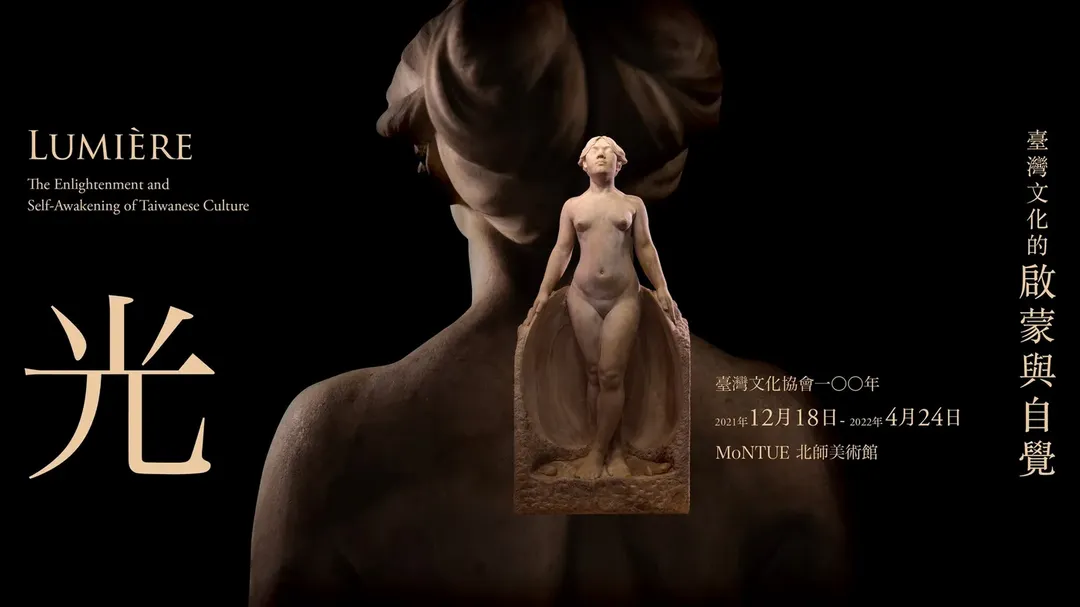
What is MoNTUE?
MoNTUE, established ten years ago, is a university art museum located under the National Taipei University of Education. In the year before "Lumiere,” the museum had already planned the exhibition “The “Everlasting Bloom, which was a phenomenon among the general public, and one of the works, “Bust of a Girl” by Huang Tu-Shui, was invited from Tai-Ping Elementary School to the museum. The exhibition showcases the spirit of the times in which this generation of artists pursued "spiritual immortality" through artistic creation over the past century (quoted from the museum's website).
At the same time, as a school established more than a century ago, the National Taipei University of Education(NTUE) nurtured the elite Taiwanese and the first generation of modern Western painters in Taiwan. During the period of the Cultural Association Movement, there were also two major waves of student activism at NTUE, during which the Taiwanese language (Taiwanese, at the time, had to be spoken in Japanese) was used as a means of resistance, and a number of students were expelled as a result, including the artist of the Lumiere exhibition. This young art museum's handling of the Cultural Association’s centennial is something that I personally would like to consider.
I think it is worth mentioning the structure of its staff at this time, which may be related to why the Kng NFT project was finalized in just one month and then actually built. The MoNTUE, which was established only ten years ago, was masterminded by Professor Lin Mun-lee, who has now retired as an honorary professor and is now the chairman of the National Culture and Arts Foundation. In the past, she served as the director of the National Palace and the director of the Taipei Fine Arts Museum, giving rise to the Taishin Art Award and the International Biennial, and so on, and as a representative of Taiwan's art and culture sector, there is no need for detailed analysis. In the middle of 2021, Wang Ruo Xuan (Rocean for short) became the new director of the museum, and the soul of the project and the smooth operation of the administrative machine are Mun-lee and Rocean (information quoted from the article in the Artouch.com - Fengjia Museum of Fine Arts and the MoNTUE initiated a vertical movement of talents, and Ye Jialong and Wang Ruo Xuan took charge of the new atmosphere of the organization). Of course, the administration team at the MoNTUE took a lot of time in this project, which is also the key to its proper operation.
Without sufficient flexibility and courage, many public/educational institutions are easily stuck in the early stages of cryptocurrency financial accounting recognition (in Taiwan, it is mainly recognized by virtual goods) when venturing into the new world we call web3, not to mention the richer and more varied attempts with NFT, which, according to personal experience, often defies the flexible and variable planning. A complete NFT project, whether commercial or non-profit, will have a large number of non-NFT activities, such as physical activities, online activities, marketing systems, community operations, etc., which requires the participation of a diverse team and invisible personnel expenses. With all the challenges, I think it is no coincidence that Kng NFT has been accomplished by MoNTUE.
Lastly, the MoNTUE is located off He-Ping East Road in Taipei, with a large beautiful floor-to-ceiling window and a subway passing by. It’s another important setor to success.
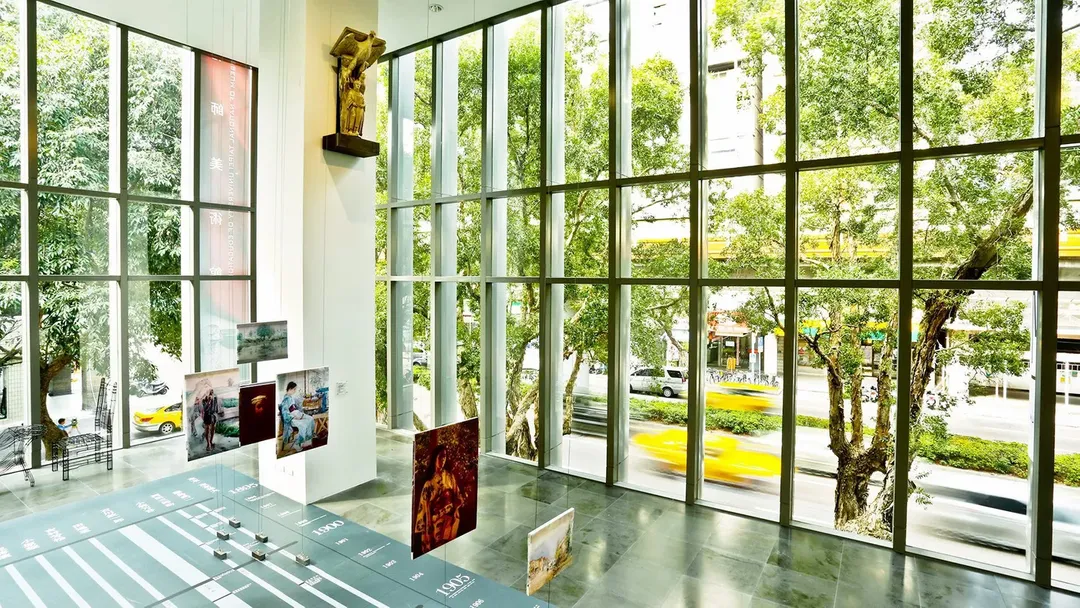
The born of the Kng NFT
With the previous introduction, let's go back to NFT itself, how was Kng NFT created? Or, based on the above basic information, how do we plan a digital asset that fits the context of “Taiwan Cultural Association and Modern Art"?
This time, the Kng NFT series is the work of artist Huang Bang-Chuan and Lin Chunni, produced by the Contemporary Revisits sub-unit of "Lumiere.
Back in early March, one month before the end of the Lumiere exhibition, we were introduced by the CEO of Taishin Art Foundation, Ms. Ya-Lee Cheng, and made a short presentation on the possibility of cultural NFTs with FAB DAO members, Hao-Ning Hsu and Wen-Chun Huang, at the MoNTUE. After reorganizing the context of the “Lumiere” exhibition, I was moved and humbled by the young advocates who were in their thirties a century ago.
The following week, the MoNTUE and the Contemporary Revisits team, Huang Bang-Chuan and Lin Chunni, began to discuss the feasibility and preliminary planning of the NFT of “Lumiere” exhibition. When discussing non-profit NFT, I usually like to start with three directions: What is the goal of the NFT project? existence to, conversation to the crowd, or to make a profit? "Existence" is the digital preservation of a vanishing object; "Dialogue" is an opportunity to create more positive mutual interaction with new collectors or old viewers; and "Profit" is the simplest concept: to obtain funds to actively implement projects that would otherwise be impossible.
From the WAC lab and my own experience, most organizations that want to use NFT for exhibitions often do so for profit, but only a few are truly successful. Success often requires detailed design and a deep understanding of the ever-changing marketplace of web3. Therefore, in the field of contemporary art, successful art NFTs are often executed in collaboration with or on behalf of web3 agents, such as Takashi Murakami, Banksy, Guo-Qiang Cai, Damien Hirst, etc. (The generative art market isn’t included here in the context of contemporary art).
From the above context, it seems that MoNTUE is quite unique in that it is a dialogue process from the very beginning, and that the NFT project is mainly an exhibition. This gave me a lot of peace of mind, because any classic artwork that is violently minted as NFT for sale would face a lot of problems, such as legitimacy (why me?) , conflict of interest (who gets the profits or losses?) The problem of ownership (who is qualified in the physical world?). Not to mention the fact that in the mass media, Water of Imortality is as sacred as the Venus of Taiwan, and if the process is not done right, there will be a public relations crisis.
Museums and galleries often translate classic IP, and the NFT world is no exception. For example, the collaboration between the National Palace and Lootex is a combination of the creator of the online popular artwork and the classic collection (e.g. Travelers amid Streams and Mountains) for sale on the shelves; in the UK, there is a pop-up store between the British Museum and Katsushika Hokusai as a case study; if the artist is commissioned to recreate the work, I call it an artwork model. The Kng Project at this time is the example. We commision young artist to re-create to exhibition as a NFT. It’s totally different concept compared to the precious model. Although the two processes are the same, the target audience, the expected benefits and the feeling of ownership are completely different.
The idea of Kng NFT originated from the artist Huang Bang-Chuan and Lin Chunni’s first idea for the exhibition “Lumiere”, Die Wege (from the left-wing poet Wang Baiyuan's poem "The Way of the Thorn"), when even the Water of Immortality had not yet been rediscovered. Die Wege first wanted to create a path of light by tracking each viewer's movements with the technique of trajectory location and photogrammetry. In 2019, artist Huang Bang-Chuan used photogrammetry to make the documentary Last Year When the Train Passed by, which won the first prize in the Experimental Competition at the Clermont-Ferrand Short Film Festival in France and the Million First Prize and Best Short Film Award at the Taipei Film Festival.
As a result of the appearance of Water of Immortality , Director Huang Bang-Chuan and Lin Chunni focused their production on the documentary of the same name and the Contemporary Revisits of The Way of the Thorn (quoted from the conversation between the two directors at the Kng DAO and FAB DAO online seminar). In addition, director Huang Bang-Chuan and Lin Chunni and the MoNTUE have a long history of collaboration and trust, having worked together since the days of immortal youth. At the end of the exhibition, Director Huang Bang-Chuan and Lin Chunni reintroduced photogrammetry as the backbone of the Kng project. Several rounds of tests were conducted to verify that the technique was feasible and that the spirit of the project was compatible with “Lumiere” exhibition.
In the past, photogrammetry was often used in forensic science, archaeology, meteorology, and other disciplines to reconstruct objects into three-dimensional objects by using multiple flat photographs. This time, the directors are using photogrammetry to recreate the “Lumiere” exhibition as a Point Cloud, which is also presented in the exhibition Water of Immortality . However, the three-dimensional point cloud file on the shelf is the only way to present the spirit of "Light" in its entirety. Similar creative methods have been used by Taiwanese artists Hung Yu Hao, Aluan Wang, and Jerrythepopper (Hung Yu Hao's work was acquired by Kevin Abosch for a high price only the months before). For example, Artogo has also used technology to scan exhibitions to reproduce the business model in the digital world.
What makes Kng NFT special is that this NFT is assembled through the gaze of the crowd and the photos taken by the participants' smart phones. This is the core feature of Kng NFT.
According to Huang Bang-Chuan, the 16mm film used in the Water of Immortality documentary is a kind of light sculpture, a subtraction. "The sculpting of light through the lens into the film's light-sensitive layer is also a subtractive technique. If the film used in the documentary "Water of Immortality " is a carved marble, then the reconstruction of the exhibition site through photogrammetric techniques and photographs taken by the public is more like a clay sculpture. (Kng NFT's creation is a kind of addition, reshaping the exhibition through the co-creation of multiple centers.
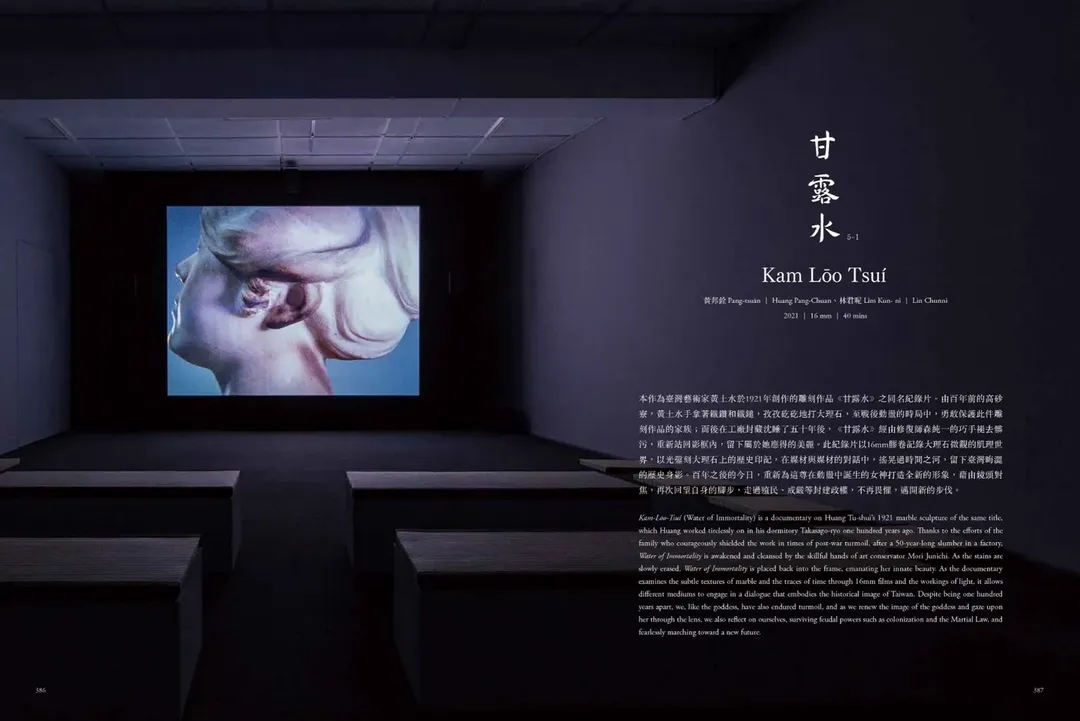
The creating process of the Kng NFT is a carefully planned After Party and workshop. On the day after the end of the exhibition, a 24-hour event was held at the MoNTUE, with workshops held in three-hour increments for eight sessions, resulting in 24 NFT works.
Participants could view the exhibition at midnight or at the dawn of the day, moments they would not normally see. At different moments, the light will appear differently on the exhibits, especially for the sculptures. As you can see in the catalogue summary, Mun-Lee Lin emphasizes the placement of "Water of Immortality " in the natural light exhibition space, in response to the artist Huang Tu-Shui 's initial production in natural light.
To quote the MoNTUE fan article, "On the closing day of the exhibition, the MoNTUE will hold a 24-hour co-creation workshop, inviting you to enter the museum at a time when you can hardly see it, and record the natural appearance of light and shadow that falls on the exhibition site at different times.
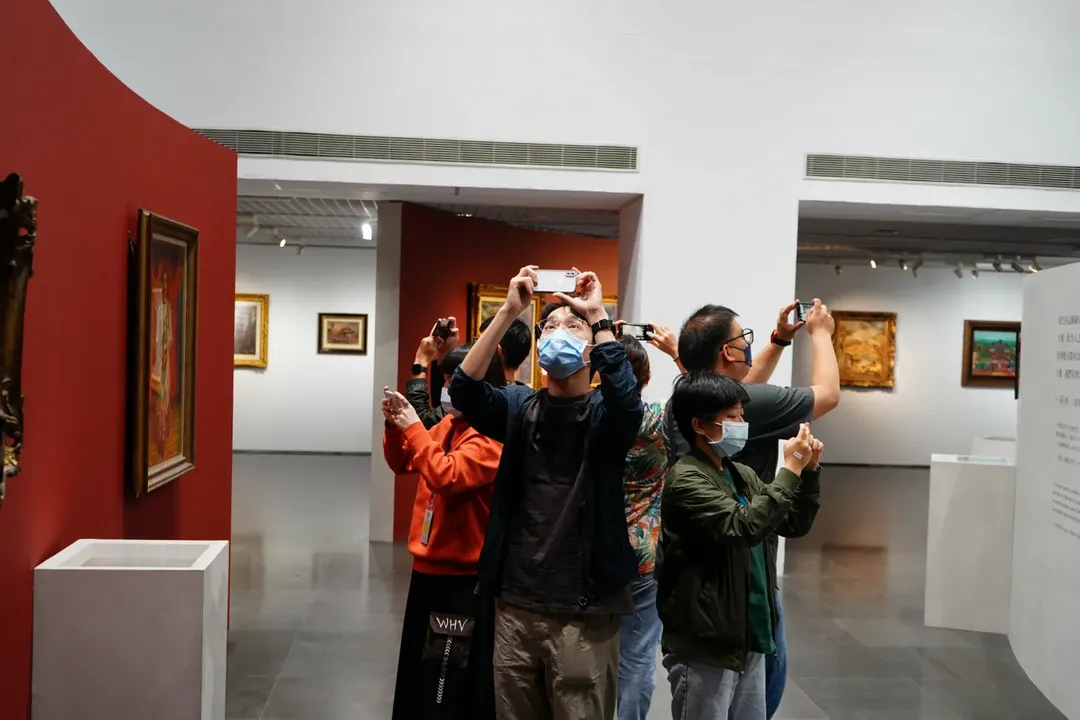
In addition, Kng NFT has a number of delicate production processes. The English name of the exhibition "Light" is Lumiere, and the name "Light" NFT is "Kng", which is derived from the Taiwanese for light. The Taiwanese language was considered the mainstay of the cultural movement in the 1920s, and many students were expelled for using Taiwanese in their speeches during the Student Movement. In addition, each NFT is named by the poet Tsai Wanxuan, such as Kng #02 Light the Lamp - the intersection of the new era of the queue, Kng #14 Frozen Dew Water - the Cultural Weed Fellowship, and Kng #17 Daylight in the Sky, all of which are symbolic elements in response to the exhibition and the Cultural Association.
Each NFT is accompanied by a vocal-free recording of the audience's voices by music/sound creators Yujun Wang and Zhen Zhou, capturing the emotions rising from the audience's hearts towards the “Lumiere” exhibition (quoted from MoNTUE fan article). These sounds were recorded in the background of the workshop and a recording device placed in the corner of the exhibition, allowing the audience to listen to the background sounds and hum along with their hearts. Afterwards, some participants said that they seemed to hear the sound of waves in NFT, and the artist Zhou Zhen said that it was the sound of the MRT passing by in the morning.
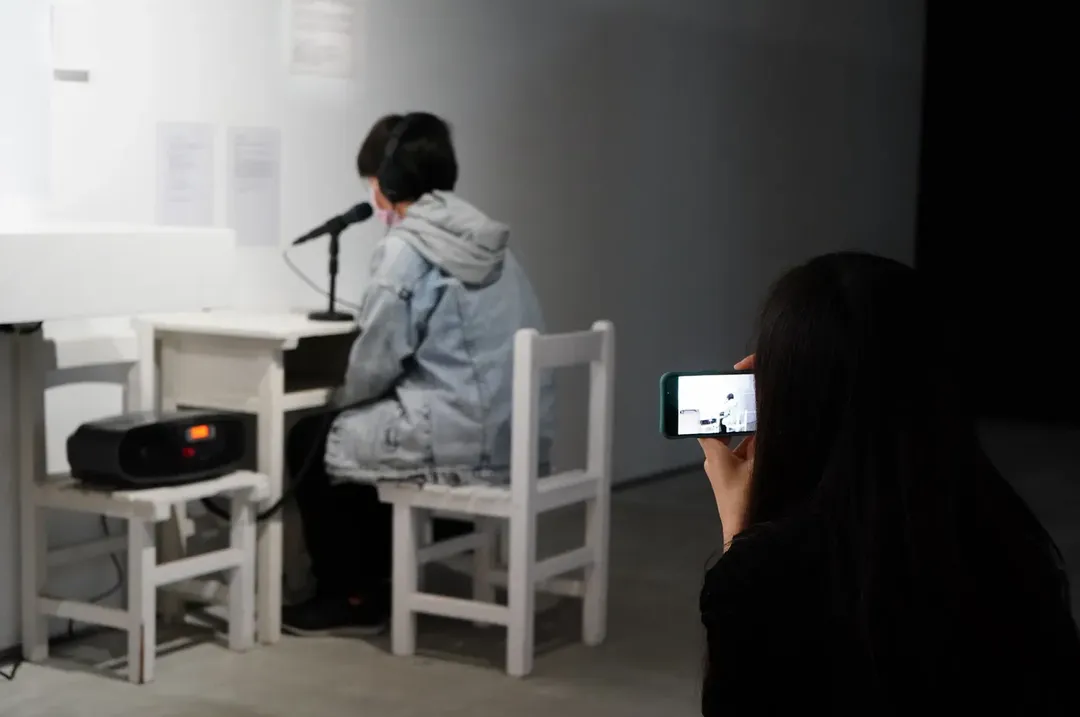
The final video post-production was made by Wu Kejun and Jiang Phish, and Kejun is also the digital video producer of the second floor exhibition The Path of Thorns. Basically, the whole contemporary reverberation team is back to work on Kng NFT. With the rhythm of proposal in mid-March, workshop in mid-April, and airdrop in May, it's really a tight schedule.
These NFTs cannot be collected through direct purchase. There are two types of Proof of Love that must be obtained. The first is to participate in the workshop, to take part in the final exhibition and filming, and to receive NFTs for the session in which you participate, for a total of 400 people; the second is to purchase the catalogue of the “Lumiere” exhibition, which sold out in a few days after it was released. Those who collected the catalogs were given a free random airdrop from Kng NFT.
With this premise, we can precisely grasp the most engaged group, which is beneficial for the subsequent community management and development. The cost of a catalogue is over NT$1,000, and the late-night workshop is a great way to filter out passionate fans who are willing to sacrifice their sleep to participate. The workshop ended successfully before the number of confirmed cases of the epidemic increased exponentially.
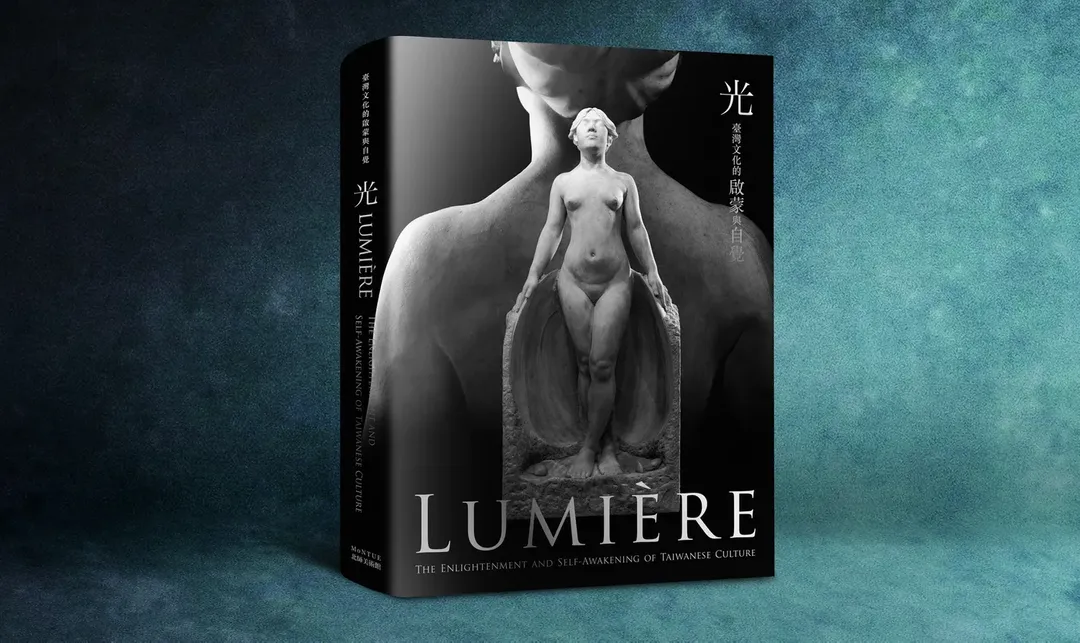
There were also two workshops that were particularly interesting.
The first one was a test workshop before the official 24-hour workshop to verify the feasibility of the photogrammetry method in practice. Since Kng NFT was published on the Tezos blockchain, nearly 40 collectors and art lovers on the Tezos blockchain were called to participate. They did not know what they would actually be participating in until they actually arrived at the event. The Tezos collector community was called because they were already familiar with NFT ownership and trading, and there was already a tight-knit community of over 1,000 people in Taiwan. It was very touching to see how many people could come on a weekday afternoon with only a three-day early call. And the test workshop became the No.0 work "Kng-huà-oo". These friends also became the early helpers in building the Kng DAO community in the future.
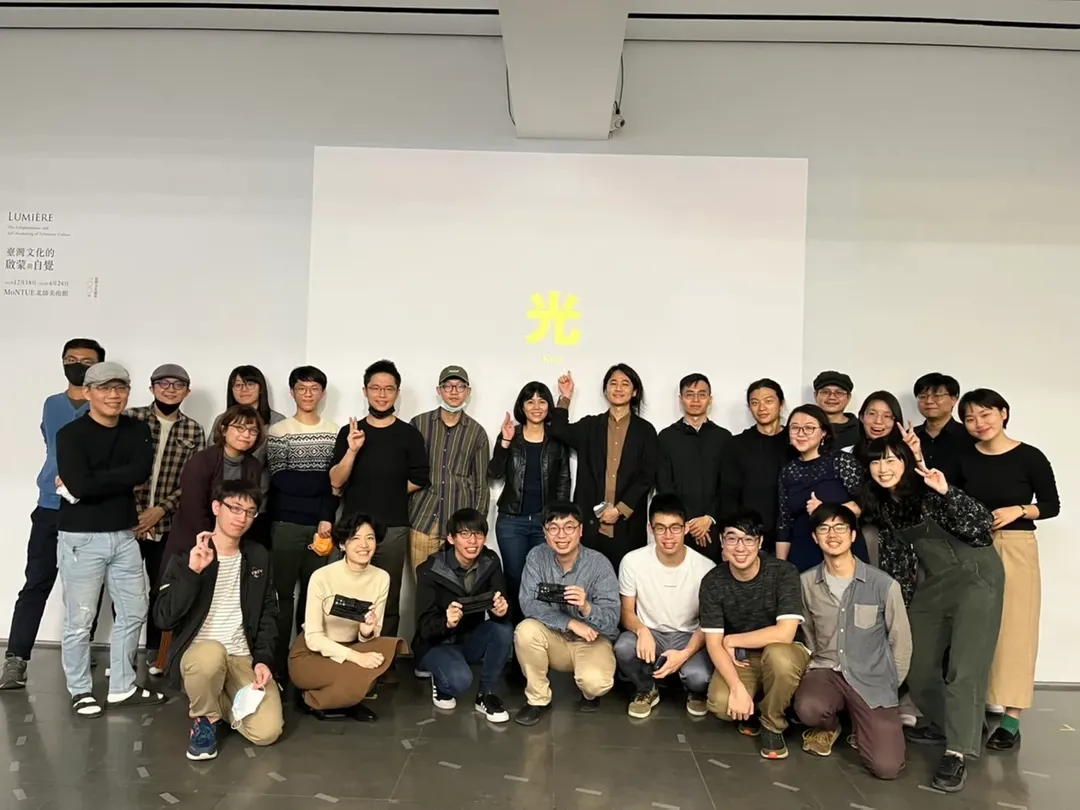
The second session was the first session of the 24-hour workshop, a special session for the artist's descendants. If you look closely at "Kng#01 Light up - Queuing the Noodle Stall in the Dark", "Kng#02 Light up - Queuing the Intersection of New Age" and "Kng#03 Light up - Queuing the Boat on the Black Sea", you will find that these are the only NFTs with human figures in them, who are the descendants of the artists in the exhibition and the exhibition research team. They include Chen Cheng-po’s granddaughter, Li Mei-shu’s son, Tân Si̍t-kî grandson and great-grandson, Chen Qing-fen’s son, Pu Tian-sheng's son, Lu Yunlin's son, Ran-In Ting’s daughter-in-law and grandson, and the Zhang family, who preserved the Water of Immortality. They also happen to be in front of the self-portrait exhibit, which was painted by their fathers and grandfathers and is now a treasure of the world. "These people, who usually make great efforts to preserve the artists' works, let us preserve their figures and voices this time. We hope that you, too, can feel the long moment in the boundless river of time. (If you are familiar with the history of the preservation and discovery of Water of Immortality , and if you re-read Chang's speech at the opening ceremony, you will be warmed by such a careful design of NFT.
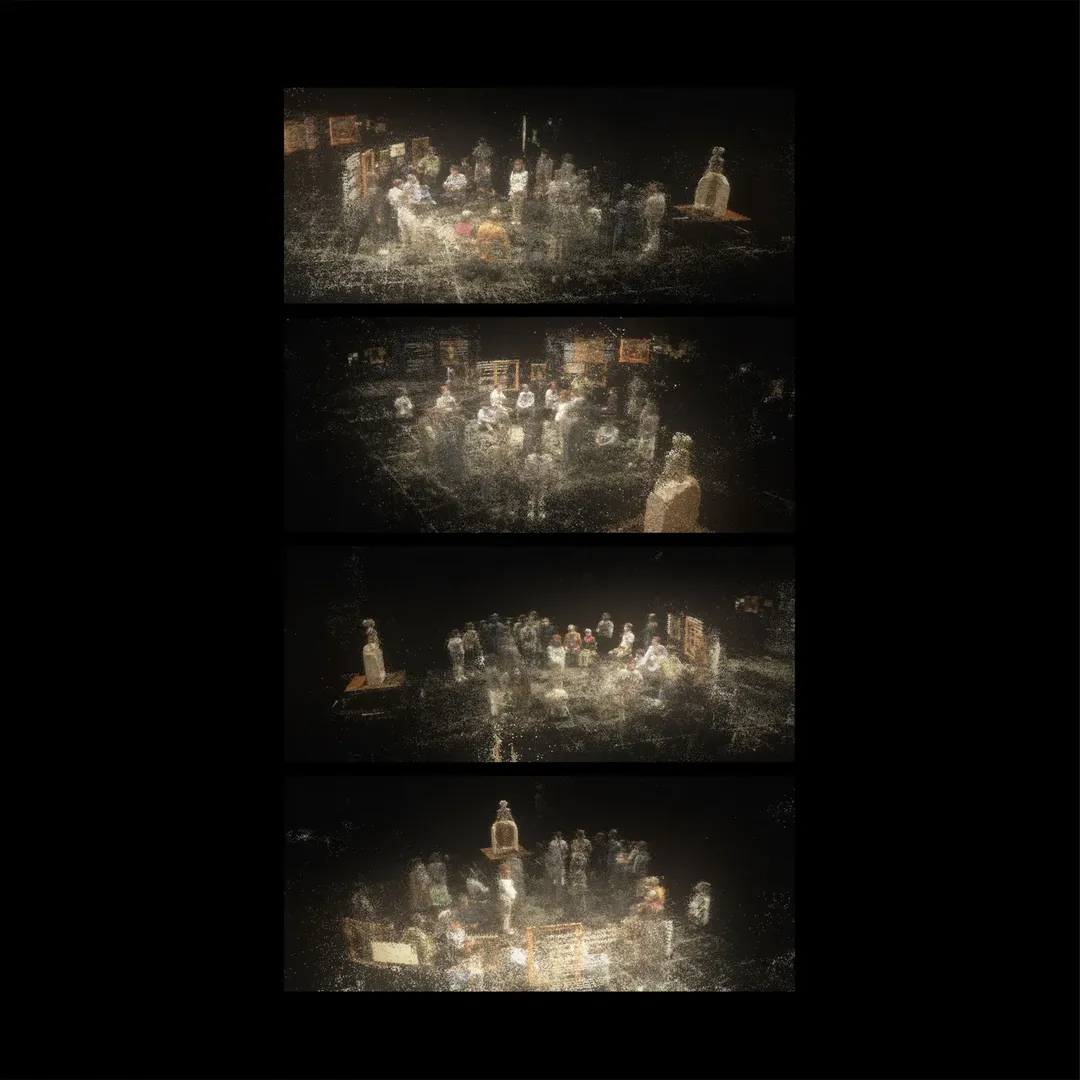
In addition to the Kng NFT body, there are some peripheral NFTs in this whole operation, such as the Hao Bang (Good Clam) and Galaxy Match series, both of which are air-dropping mediums.
One hundred years ago, the first aviator in Taiwan, Hsieh Wen-Ta, airdropped a petition for the Taiwan Parliament Movement over Tokyo.

The initial idea of a Good Clam was actually a consideration of experience design. We wanted people who had the catalog to get immediate feedback when they finished the airdrop application process. However, Kng NFT had to wait until the workshop and post-production were completed to get it, and the catalogue was available for sale much earlier than the workshop, hence the birth of Good Clam. The Good Clam is taken from the marble mussel shell at the foot of "Water of Immortality ", Huang Tu-Shui’s mussel shell is spitting water, and the Good Clam is a 3D interactive NFT, when you click on it, it will reluctantly open, but only when the time is up will it open fully and let you see what it looks like inside.
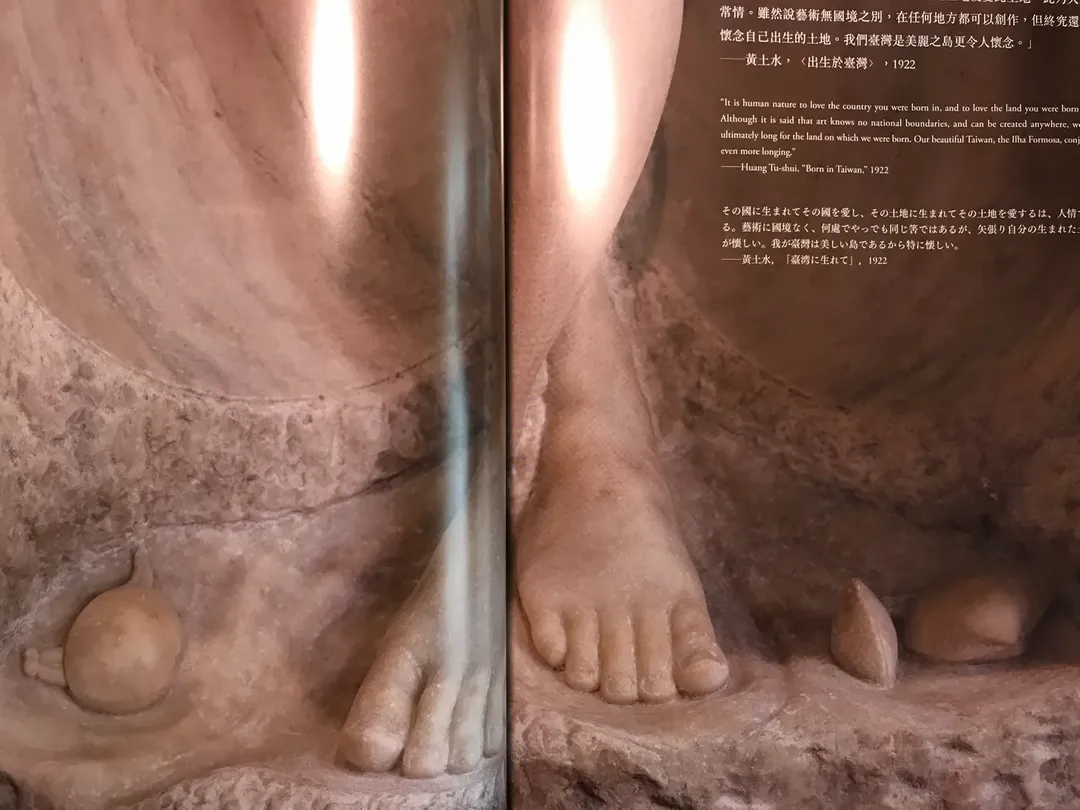
When you hold the clamshell, the address will receive the real Kng NFT when the time comes, so the clamshell becomes the exchange ticket, and the exchange ticket can be circulated in the market, if the ancient coins like shells in the past.

The Galaxy matches are souvenirs of the Kng DAO Discord event, the name of which is taken from the Galaxy Bar. The two directors also made a short film on the subject, "Before the Dawn", which is now used as a meme for the community to create a new type of lecture/salon.

The Kng DAO
The Kng NFT project has attracted an active audience thanks to the aforementioned community-oriented design, which has made the Kng DAO Discord run smoothly from the beginning, with the Kng DAO structure being run by MoNTUE, with two directors as the sub-channel Galaxy Bar hosts, holding regular events and dialogues with the audience. The entire Discord attracted about 700 people in the first month of its existence, and the first opening of the Galaxy Bar with 100 attendees was astonishing. Although the scale of the project was not large compared to commercial NFT projects, it was a good result for an arts and cultural event, a non-profit NFT operation.
In retrospect, the "dialogue" that we set out to achieve must have been achieved.
Kng NFT has a redemption rate of about 60%, which is beyond my imagination in terms of picture redemption. Compared to the AiSMR NFT exchange rate of A-Mei's concert, it is about the same. This may be the limit for the traditional world to enter the web3 community.
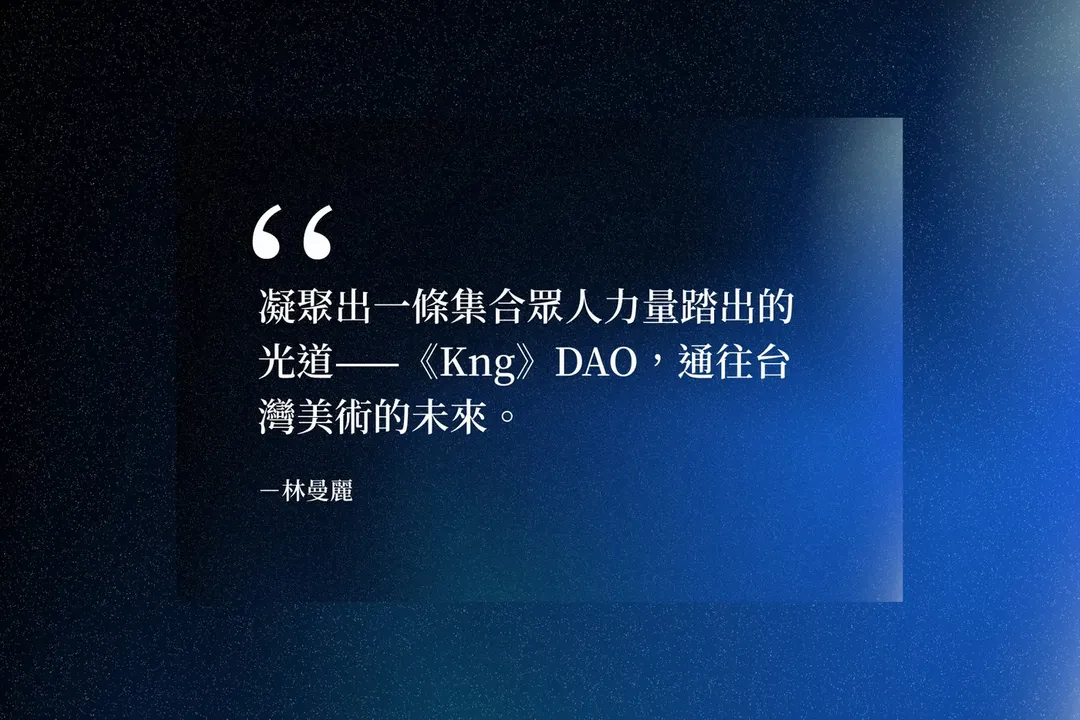
As for the future of Kng DAO, let's look forward to where MoNTUE will lead us.
Discussion
I have written a long paragraph above in order to describe the details as much as I can, and I think it may be a little exemplary for subsequent NFT releases by arts and culture organizations, or at least a little precedent to follow. Of course, it is easy to be one-sided or subjective, but I still think that Kng NFT is a relevant, quality and moving NFT project. Please feel free to correct me if there is anything wrong.
Conceptually, it is a variation of POAP, which stands for Proof of Attendence Protocol, a way to prove that you have participated in an event and receive a badge, the best known overseas example being POAP.xyz. Kng NFT is designed to be more genuine than POAP in that the collector's actual participation becomes part of the artwork itself (you can see it on the website). The actual participation of the collector becomes part of the work itself (you can see the name of each participant in the floating box, which is one of the photos they took). This presence, like a converging snake, is connected at the beginning and end, and you must participate in order to claim it, and by claiming it, you become a small part of the activity you have participated in, a part of the consensus, and even your voice. A simple analogy is that when you were a child, you would stamp your name in different areas of the museum; nowadays, the museum uses new media and technology to make the proof of participation more permanent, and the participant also casts the moment of the exhibition into eternity, and it is officially issued with a certificate.
In terms of presentation, this is an interactive, three-dimensional point cloud with sound. It is a time-based work, and must be rotated, zoomed, and panned by the viewer's hand to reveal the three-dimensional composition of the particles, otherwise it is merely flat from a visual perspective.
In the sense of the times, this is a record of the exhibition, but from the viewer's point of view, this is the first time that "Water of Immortality " has been reintroduced to the public, and it is also a collection of works of enlightenment from the era of the Cultural Council Movement. If you click on different Kng NFTs, you will find that the starting point is a different perspective, which is from the viewer's point of view, different from the traditional global view of Kng NFT. It is a collection of vital gaze.
Such a detailed NFT operation is not something that can be done by an agent, and it can only be accomplished through the collaboration and communication between the official museum, the curatorial production team, and those familiar with NFT (in this case, FAB DAO). I still find it a great challenge to complete the NFT project with limited funds and time.
I am an optimist, and I think there are still very many possibilities for NFT, and there is still a lot of room to explore in the field of art and literature, it could be a ticket, it could be a shareholding, it could be a work itself, it could be an unofficial mindmaking vehicle. At the same time, I also think that new forms of web3 services have great potential for community and social progress, especially digital tools that apply radical market theories. Thanks to MoNTUE and the production team of “Lumiere” exhibition Contemporary Revisits Team, I was able to participate in the project and explore the NFT project from scratch in just a few months, which fits so well with the exhibition.
I hope that Formosa Art Bank will slowly take off and explore more new ideas and implement them at the beginning of the web3 era, just like its predecessors did 100 years ago.
This article is dedicated to the MoNTUE team and the two directors.
(The picture is a four-sided screenshot of NFT's "Kng#01 Light the Lamp - The Noodle Stall in the Queue")
